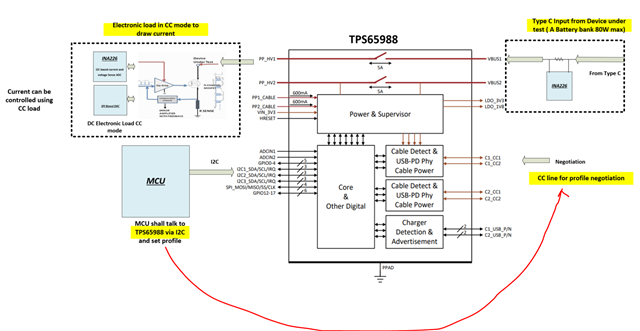Other Parts Discussed in Thread: TPS25750, TPS25750EVM
Hi there,
We are currently designing an tester board, USB Type C based electronic load to test our product USB Type C and USB Type A BC 1.2 based device (kind of power bank, but a huge one).
The role of the electronic load is to mimic actual load such as laptop USB charge port, mobile charge port etc. by sinking and dissipating power at different profiles ( 5V 3A, 9V 3A ..20V 3A etc).
For this I'm planning to use TPS65988 in sink mode ( please suggest any alternative if available).

i'm attaching a crude block diagram
a) The input is from a USB Type C based power bank capable of providing 80W ( based on profile detection /negotiation)
b) TPS65998 shall be controlled through and MCU via I2C to set the profile
c) We have an electronic load in CC mode to sink the current
Questions:
a) Is the above solution optimum ( else please suggest an alternative) ?
b) Does TPS65988 comes with pre programmed firmware and how much effort it is required to control the profile via I2C.
Contd.
We also have some USB A BC 1.2 supported port coming out of battery bank. Can I use same setup except, will use D+ D_ line for handshaking. Is there any I2C configurable register available to set the max current? say 5V 3A . ( The level of current shall be controlled by electronic load)
Thanks in advance
-MI

